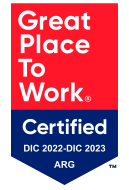
Felipe Fernandez Melo
Scrum Master and member of the Team Adviters.
Over the years working with agile methodologies, I realized that some of the projects did not achieve the expected result using a traditional agile methodology known as Scrum, which as we know is an agile framework and one of the most used in project management focused on collaboration, flexibility and incremental delivery of results.
Through short cycles called «sprints», teams work on priority tasks, adapt to changes and generate functional deliverables at the end of each sprint. Constant communication, different ceremonies such as daily, planning, review, retros and continuous feedback have been key pillars of Scrum, allowing teams to optimize quality and efficiency in the completion of projects in an iterative manner. Scrum has been fundamental in the development of my career as it allowed me to take better-organized projects and even participate in scaling to another level with multiple teams.
While for large companies and projects, it worked in most aspects, for other projects it did not adapt in the best way, and thanks to the fact that I had the opportunity to choose the way I wanted to work and organize the teams, I understood that for some projects applying certain principles of different methodologies and restricting the number of meetings led me to complete projects on time and delivering quality and value to the customer.

Introducing a Hybrid Agile Methodology
I bring to this article a kind of agile hybrid methodology that helped me to successfully complete projects in a short time and with quality. In particular, it was focused mainly on remote teams, flexible work environments, autonomous, and collaboration.
Below, I describe some key points and principles:
Hybrid Agile Methodology: Key Points and Principles
Objectives:
Optimize workflow in agile teams, eliminating the need for conventional follow-up meetings. With a focus on continuous value delivery and rapid adaptation that enables teams to maximize their productivity and collaboration efficiently.
Principles and Values:
Principles: Focus on delivering value, promote continuous collaboration and communication, adapt to change, and eliminate waste.
Values: Transparency, flexibility, team autonomy, and focus on results.
Roles and Responsibilities:
- Product Owner: Responsible for defining and prioritizing the product backlog.
- BA: Responsible for downloading detailed functionalities, acceptance criteria.
- UX UI Designer: Responsible for the design of the functionality’s prototypes.
- Project Manager: Facilitator and responsible for ensuring compliance with the methodology, helping the team to apply the principles and practices. He organizes the work and keeps the Kanban updated, he is in charge of unblocking internal and external impediments that the team has.
- Development and testing team: Responsible for developing and testing user stories and collaborating in planning and decision making.

Processes and practices:
- Iteration planning: The team sets clear goals and selects user stories to implement during the iteration.
- Backlog management: The Product Owner maintains a well-defined product backlog ready for implementation at any time.
- Work estimation: The team uses estimates in days to plan and track outstanding work more accurately
- Reviews and demonstrations: Periodic demonstrations are conducted to share the value increments developed and get feedback.
Artifacts:
- Product backlog: Prioritized list of user stories and backlog items to implement.
- Sprint backlog: Selection of user stories to implement during the current iteration.
- User stories: Descriptions of the functionality or requirements that add value to the product or project.
Ceremonies:
- Weekly: Weekly alignment meeting to review progress, identify roadblocks and adjust priorities.
- Sprint Demo: Presentation of the value increments developed during the iteration to obtain feedback. Generally, a single demo, but can be partitioned according to customer need and timing.
- The sprint planning does not require a meeting, the backlog and sprint backlog are kept updated with their priorities to be taken and the team is responsible for reviewing the stories and determining the estimate in days, if something punctual arises it is communicated directly with the PO or BA.

Tools and Technologies:
- Kanban board: Tool to record and visually track user stories and their progress. Project Manager keeps it always up to date.
- Online communication platforms: Use of collaborative chat tools to maintain fluid communication between team members.

Workflow:
- Sprint backlog items move from one column to another on the Kanban board, reflecting their current status.
Benefits and advantages:
- Increased productivity and collaboration without the need for conventional follow-up meetings.
- Rapid adaptability to changes and greater flexibility in workflow.
- Elimination of waste and focus on value delivery.
Principles:
- No daily: No formal daily meetings are held. Instead, continuous and transparent communication among team members is encouraged throughout the day using online collaboration tools and agile communication channels.
- No grooming: Traditional grooming meetings are eliminated. Instead, it encourages the creation and maintenance of a well-defined and up-to-date product backlog or user stories that are ready for implementation at any time.
- Planning: Asynchronous planning where the member assumes or is assigned the task to review and estimate, always maintaining a fluid communication via chat, if there are more doubts, you can make a short meeting with the member or wait for the weekly meeting.
- No refinement: No formal refinement meetings are held. Instead, a continuous approach to refinement and clarification of backlog elements is encouraged as questions or concerns arise during development.
- No retro: Retrospective meetings are not part of the process. Instead, teams are encouraged to engage in constant feedback and reflection during the development of iterations, allowing for continuous adjustments and improvements.
- One or some demos: includes periodic demonstrations to share and get feedback on the work done. These demos are scheduled as needed and focus on delivering functional, deployment-ready increments of value.
- Iterations of 3 weeks or a month: use iterations of longer duration, lasting 3 weeks or a month. This provides teams with sufficient time to complete tasks and achieve the objectives set for each iteration.
- Estimates in days: Estimates are made in days instead of story points, which makes it easier to plan, estimate and track the work to be done (carryover).
- A weekly meeting to maintain regular alignment and effective communication within the team. Focused on reviewing progress, identifying and addressing potential obstacles, and adjusting priorities if necessary. The goal is to ensure that all team members are informed and aligned, without falling into an excessive number of meetings.
- To foster efficient collaboration, the use of a single collaborative chat is proposed. This chat acts as a centralized space for team members to interact, share updates, ask questions, and collaborate in real-time. By having a single collaborative chat, communication dispersion is avoided and access to relevant information is facilitated.
As described above in my experience it helped me both in new projects with the creation of MVPs and also in projects already implemented that were in an evolutionary-corrective stage where the delivery of functionality and the addition of value was continuous. I consider that it has aspects of the Lean methodology, some points taken from Scrum, and the use of Kanban for tracking and constant updating of tasks.
Finally, these points may help in part or in full in the management of some software projects, but as I remarked they have to be given the conditions of a flexible work environment to be able to implement it.
If you had a good time reading this article, why not share it with your colleagues? We’ve got plenty more content like this waiting for you on our website.






